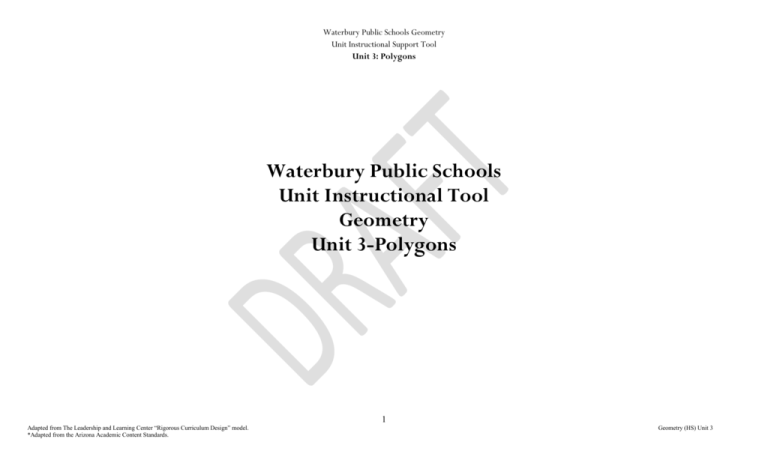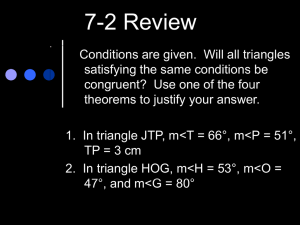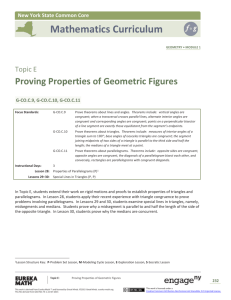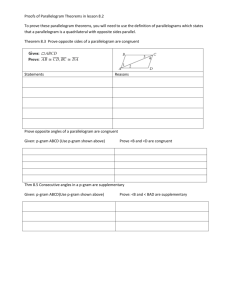5 - Waterbury Public Schools
advertisement

Waterbury Public Schools Geometry Unit Instructional Support Tool Unit 3: Polygons Waterbury Public Schools Unit Instructional Tool Geometry Unit 3-Polygons 1 Adapted from The Leadership and Learning Center “Rigorous Curriculum Design” model. *Adapted from the Arizona Academic Content Standards. Geometry (HS) Unit 3 Waterbury Public Schools Geometry Unit Instructional Support Tool Unit 3: Polygons Pacing: 4 weeks + 1 week for re-teaching/enrichment =20 periods + 5 periods re-teach/enrichment-25 days total Mathematical Practices Mathematical Practices #1 and #3 describe a classroom environment that encourages thinking mathematically and are critical for quality teaching and learning. Practices in bold are to be emphasized in the unit. 1. Make sense of problems and persevere in solving them. 2. Reason abstractly and quantitatively. 3. Construct viable arguments and critique the reasoning of others. 4. Model with mathematics. 5. Use appropriate tools strategically. 6. Attend to precision. 7. Look for and make use of structure. 8. Look for and express regularity in repeated reasoning. Standards Overview Prove geometric theorems. Make geometric constructions. 2 Adapted from The Leadership and Learning Center “Rigorous Curriculum Design” model. *Adapted from the Arizona Academic Content Standards. Geometry (HS) Unit 3 Waterbury Public Schools Geometry Unit Instructional Support Tool Unit 3: Polygons Periods 10 5 Priority and Supporting CCSS CC.9-12.G.CO.10 Prove theorems about triangles. Theorems include: measures of interior angles of a triangle sum to 180 degrees; base angles of isosceles triangles are congruent; the segment joining midpoints of two sides of a triangle is parallel to the third side and half the length; the medians of a triangle meet at a point. CC.9-12.G.CO.13 Construct an equilateral triangle, a square, and a regular hexagon inscribed in a circle. Performance Objectives Prove and use theorems about triangles including, but not limited to: Prove that the sum of the interior angles of a triangles = 1800. Prove that the base angles of an isosceles triangle are congruent. Prove that if two angles of a triangle are congruent, the triangle is isosceles. Prove the segment joining midpoints of two sides of a triangle is parallel to the third side and half the length. Prove the medians of a triangle meet at a point. Suggested Instructional Strategies Construct an equilateral triangle, a square, and a regular hexagon. Construct an equilateral triangle, a square, and a regular hexagon each inscribed in a circle. Identifying Similarities and Differences Note Taking Summarizing Cooperative Learning Nonlinguistic Representations Vocabulary Development Use paper folding to demonstrate relationships in triangles. Use similar triangles or dilations to show that the mid-segment is parallel and half the length of the third side of a triangle. Use dynamic geometry software to explore relationships in triangles. Write proofs in a variety of formats. Identifying Similarities and Differences Note Taking Summarizing Cooperative Learning Nonlinguistic Representations Vocabulary Development Allow students to explore possible methods for constructing equilateral triangles, squares, and hexagons, and methods for constructing each inscribed in a circle. Pre-Requisite Knowledge Resources Lesson: Pennant Pride Prove theorems about lines and angles (II.5 G.CO.9). Understand the properties of regular polygons. Construct congruent segments and perpendicular lines. Task: Pennant Pride Smart Exchange Lesson: Interior Angles of a Triangle Teach21 Lesson Plan ALEX Lesson Plan: Investigation of Special Segments of Triangles Median of a triangle Quadrilateral Diagonals ML Geometry Concept & Skills: 6.3 Geometrica Fights Back Properties of Parallelograms Geometry (A): READ: Proving Quadrilaterals are Parallelograms … 3 Adapted from The Leadership and Learning Center “Rigorous Curriculum Design” model. *Adapted from the Arizona Academic Content Standards. Geometry (HS) Unit 3 Waterbury Public Schools Geometry Unit Instructional Support Tool Unit 3: Polygons Periods 10 Priority and Supporting CCSS CC.9-12.G.CO.11 Prove theorems about parallelograms. Theorems include: opposite sides are congruent, opposite angles are congruent, the diagonals of a parallelogram bisect each other, and conversely, rectangles are parallelograms with congruent diagonals. Performance Objectives Prove and use theorems about parallelograms including, but not limited to: Opposite sides of a parallelogram are congruent. Opposite angles of a parallelogram are congruent. The diagonals of a parallelogram bisect each other Rectangles are parallelograms with congruent diagonals. Suggested Instructional Strategies Identifying Similarities and Differences Note Taking Summarizing Cooperative Learning Nonlinguistic Representations Vocabulary Development Use geometry software to reflect a triangle across one of its sides. Show that any two intersecting segments that bisect each other create the diagonals of a parallelogram. Use properties of parallelograms to find missing measures in geometric figures. Pre-Requisite Knowledge Resources GeoGebra in 10 Lessons Computing Pi Know the definition and properties of parallelograms. Geometric Constructions Construct This! Construction Worksheets 4 Adapted from The Leadership and Learning Center “Rigorous Curriculum Design” model. *Adapted from the Arizona Academic Content Standards. Geometry (HS) Unit 3 Waterbury Public Schools Geometry Unit Instructional Support Tool Unit 3: Polygons Concepts What Students Need to Know Skills What Students Need To Be Able To Do Bloom’s Taxonomy Levels ● theorems about triangles ● PROVE 5 ● theorems about parallelograms ● PROVE 5 Essential Questions In what ways can we prove that triangles and parallelograms are congruent? Corresponding Big Ideas Proving and applying congruence provides a basis for modeling situations geometrically to solve problems. Unit Assessments The items developed for this section can be used during the course of instruction when deemed appropriate by the teacher. Skill-based Task Construct an equilateral triangle inscribed in a circle using a compass and straight-edge. Problem Task Find two ways to construct a hexagon inscribed in circle as shown. 5 Adapted from The Leadership and Learning Center “Rigorous Curriculum Design” model. *Adapted from the Arizona Academic Content Standards. Geometry (HS) Unit 3 Waterbury Public Schools Geometry Unit Instructional Support Tool Unit 3: Polygons Skill-Based Task: Prove that the base angles of an isosceles triangle are congruent. Problem Task: Write a paragraph explaining why the segment joining midpoints of two sides of a triangle is parallel to the third side. Skill-Based Task: Write a two-column proofs showing that opposite sides of a parallelogram are congruent. Problem Task: Write a paragraph proof showing that a rectangle is a parallelogram with congruent diagonals. 6 Adapted from The Leadership and Learning Center “Rigorous Curriculum Design” model. *Adapted from the Arizona Academic Content Standards. Geometry (HS) Unit 3




